Pests
-
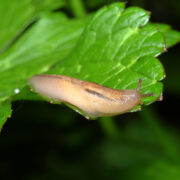
Garden slugs
Garden slugs
-
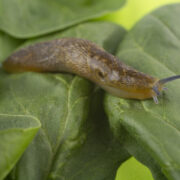
Grey field slugs
Grey field slugs
-
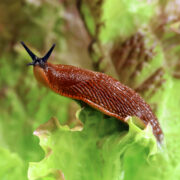
Spanish slugs
Spanish slugs
-
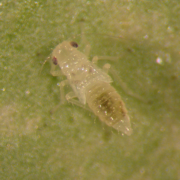
Leaf Hopper
Leafhoppers are widespread, serious pests of many crops, whether grown under protection or outdoors. Leafhopper damage can lead to substantial crop losses and cosmetic damage to fruiting crops leading to unsalable product. The glasshouse leafhopper, Hauptidia maroccana will cause damage to a range of protected crops e.g. cucumber, tomato, herbs and ornamentals. Common weed hosts include chickweed therefore hygiene measures to remove host plants are an important control measure. Adult leafhopper are whitish-yellow, with two dark grey chevron-shaped marks on the wings. The nymphs are whitish without any distinctive markings. The parasitoid Anagras atomus can give some protection against leafhopper infestation but where significant pest levels exist control with compatible chemical controls is recommended.
-
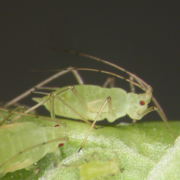
Aphids
Aphids are specialised feeders on plant sap. They insert their tubular mouthparts into the transport vessels on plant leaves, stems or roots, and feed on the sap which flows there. Because this sap is rich in sugars but poor in the other nutrients which aphids need, they excrete large amounts of excess sugars as honeydew. Typically, aphids are soft bodied fat-looking insects, between 1 and 4 mm long, which cluster around the terminal shoots or under the leaves of plants. The majority have a pair of prominent tubular structures pointing backwards on the back of the body. They range from green to black in colour, and individual species may have several colour forms. Some produce wax, which coats their bodies and can give them a grey or white appearance. Aphid colonies can grow very rapidly, covering foliage and weakening the plant. The copious amounts of honeydew produced encourages the growth of sooty moulds, which further weaken the plant. Feeding by some species can produce distortion of the leaves. Aphids are also important vectors of plant viruses. Aphid life history is complex. Some species from temperate regions alternate between winter and summer hosts. During summer, all the individuals are female, and can produce several live offspring per day, each of which is ready to feed and already contains the embryos of the next generation. The majority are wingless. As colonies grow, the aphids become crowded and the plant quality declines. This leads to the production of winged or alate aphids which are able to leave the plant and found fresh colonies. As winter approaches, these species produce winged male and female forms, which migrate to the winter host and mate. The females will then lay over-wintering eggs before dying. Many of the common pest species have forms which do not have this sexual phase: they reproduce continuously throughout the year in protected crops. There are several common pest species which occur on a wide range of different crops:-
- Aphis gossypii – This forms part of a species complex, with many similar species and forms, some of which are associated with specific host plants. Individuals within the same colony can range in colour from pale green to almost black, and some have a light coating of wax which gives a grey colour.
- Myzus persicae – This species is extremely common on protected and outdoor crops, and has developed resistance to a wide range of classes of insecticide. It occurs in green, orange and red colour forms. The tobacco aphid (Myzus persicae nicotianae) is often referred to as Red Aphid can often be found on pepper crops.
- Macrosiphum euphorbiae – This is a larger aphid with long antennae, which also occurs in a range of colour forms.
- Aulacorthum solani – This is a medium sized aphid which can cause severe damage even at low populations. Typical symptoms include the development of large yellow patches on affected leaves.
-
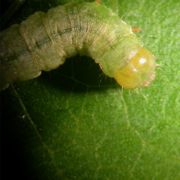
Caterpillars
The larvae (caterpillars) of various species of moth and butterfly produce plant damage, mainly by feeding on foliage, but also in some cases by burrowing into developing fruit, or into plant stems or roots. Some species are very selective and will feed on only a single species or family of plants, whereas others are able to feed on a wide range of plant species. In severe cases this feeding can lead to total defoliation or collapse of the plant. In less severe cases the crop yield will be reduced, or produce is made unmarketable by the presence of caterpillars in fruit. Other species cause post-harvest damage by feeding on stored products such as grains and dried fruits. Adult females lay eggs singly or in groups, depending on species, often carefully selecting a host plant by using chemical cues. These eggs hatch to produce tiny larvae, which quickly begin feeding. Patterns of leaf damage are very variable, depending on the species and stage of the larvae, and whether they are solitary or gregarious feeders. Foliar damage by young larvae may be limited to the under surface of leaves, showing as transparent ‘windows’. Larger larvae may consume the leaf from the edge, often leaving the main leaf veins intact. Other species may consume the veins as well, making them more difficult to locate. Larvae which start out by feeding on leaves may move into fruit as they grow. Often the droppings, which are in the form of black pellets, provide an indication of the location of a caterpillar. Other, usually smaller, species protect themselves by rolling leaves or binding several leaves or petals together with silk. These are difficult to control, and can cause major aesthetic damage on ornamental plants.
-
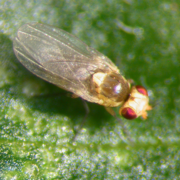
Leafminer
Adult female leaf-miners produce characteristic feeding marks on leaves, and lay eggs into some of these. The solitary larvae of these flies feed within the leaf, leaving trails or ‘mines’ which grow rapidly in length and width. In serious cases the leaf area is reduced enough to affect crop yield, whilst in ornamental crops the damage is highly visible and results in loss of value. Liriomyza huidobrensis - The Serpentine, South American Leaf-miner or Pea Leaf-miner Liriomyza trifolii - The American Serpentine Leaf-miner Liriomyza bryoniae - The Tomato Leaf-miner Liriomyza sativae - The Vegetable Leaf-miner Phytomyza syngenesiae - The Chrysanthemum Leaf-miner The adults of the four Liriomyza spp. are very difficult to distinguish from each other, being predominantly brown with a clear yellow spot on the thorax. The larvae of L. trifolii are uniformly yellow, whereas the other Liriomyza species are white with a yellow front end. When mature, the larva emerges from the leaf through a slit in the mine, and forms a puparium which is initially pale but which becomes dark brown. Some of these pupariae will remain on the leaf surface, but others drop to the ground. L. huidobrensis is recorded from several hundred species of plant. Phytomyza syngenesiae is a larger species which is predominantly grey, and lacks the yellow spot on the thorax. Larvae do not emerge from the leaf, but form the puparium within the mine made by the larva. This species mainly attacks plants in the family Compositae. Duration of development of Liriomyza bryoniae at fixed and fluctuating temperatures. From Minkenberg and Helderman (1990)
-
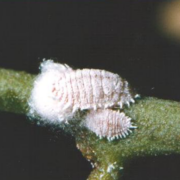
Mealy bugs
Mealy bugs are insects which are covered with a white waxy powder. They feed in groups by puncturing the leaves and sucking out a meal of plant sap. They secrete honeydew that can lead to secondary disease infections such as sooty moulds. Males have a single pair of wings and fly to spread their populations. Mealy bugs feed on a variety of plants such as ornamentals, cut flowers, vines, citrus, tomatoes and peppers. The increased adoption of integrated control in protected crops has resulted in mealy bugs becoming an important secondary pest. This is due to the fact that the use of broad spectrum insecticides that had a side effect on mealybugs has been replaced by the use of more specific insecticides and biological controls. Control strategies for mealy bug usually include more than one control measure, such as the generalist mealybug predator Cryptoline (Cryptolaemus montrouzieri) used in conjunction with a species specific parasite such as Anagyrline (Anagyrus pseudococcus).
-
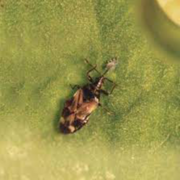
Psyllids
There are many different species of Psyllids (Jumping plant lice) as each species is plant specific. They are often found on fruit trees such as apples, pears and apricots. In crops such as pears they may have eight generations in one season. They can also be found on ornamental plants such as Buxus sempervirens. They are plant sucking pest that will drink from the phloem system of the plant, they will often attack the soft tissue at the growing point causing the leaves to turn yellow, distort and die back. They also produce honeydew resulting in secondary infestations of sooty moulds which can affect fruit quality and saleability. Adults (2-3 mm long) are reddish brown in colour with transparent wings and strong jumping legs. They are very active and will hop or fly away when disturbed. Nymphs are flat and elliptical in shape, almost scale-like. They are less active than adults and are most numerous on the undersides of leaves. Newly hatched nymphs are yellowish in colour but turn green as they mature. They over winter in the bark of the plants and emerge in early spring to mate Antholine (Anthocoris nemoralis) realeased at the first signs of infestation in spring can give control in crops such as buxus and pears. Other generalist predators such as Ladybirds (Adaline) and Lacewings (Chrysoline) will also predate on psyllids.
-
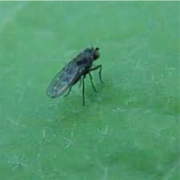
Shore flies
Shore Flies are usually found in wet places, and have a close association with algae. They are in the genus Scatella, which belongs to the family Ephydridae. Those found in glasshouses were mainly believed to be Scatella stagnalis, but some populations are now believed to be of S. tenuicosta. The adult flies are black and thick bodied, with short antennae. They are easily distinguished from Fungus Gnats, which are slender and fragile in appearance, with long antennae. Whilst not causing direct damage to plants, they can cause problems for cut flower and herb growers because they mark the petals with their faeces. They also cause problems when they get caught in packaging prior to sale: neither the retailers not their customers like to see small black flies packed with their food or flowers. The larvae are short and very leathery in appearance, with a prominent ‘breathing horn’ at the rear end. Unlike Fungus Gnats, there is no obvious black head. They are normally closely associated with the wettest areas, where algae are common.
-
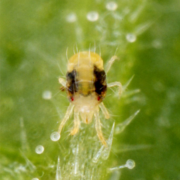
Spider Mite
Red or Two-Spotted Spider-Mites (Tetranychus urticae) feed by puncturing cells and draining the contents, producing a characteristic yellow speckling of the leaf surface. They also produce silk webbing which is clearly visible at high infestation levels. At very high infestation levels, reddish-brown masses of mites can be seen hanging from the tips of leaves. When populations of spider mite are this high, the pest can be transferred accidentally to clothing, and spread around the crop by workers. Spider mites are common pests on many vegetable and ornamental crops, including tomatoes, cucumbers, peppers, strawberries, roses, gerbera and many other species. Mites enter an over-wintering state known as diapause in autumn, and seek hiding places in the glasshouse structure or on equipment. They will emerge from diapause in the spring and can re-infest the crop. Over-wintering forms are usually bright red, but red forms also occur later in the year. Certain strains produce more severe ‘hyper-toxic’ damage, leading to severe leaf damage and leaf loss at low population densities. The exact cause of this damage is unknown, but these ‘hyper-toxic’ mites are usually considered to belong to the species Tetranychus cinnabarinus, or Carmine Mite, and are generally red in colour. Recent research also shows that these more damaging mites are able to lay more eggs than standard forms. Green forms of T. cinnabarinus are now known to occur, but do not appear to cause the same type of damage. Distinguishing between the species is not easy, and some taxonomists still consider T. cinnabarinus to be a form of T. urticae. Other species of Tetranychus, such as T. evansi, T. turkestani and T. pacificus also cause crop damage in some countries. Related mites such as the Fruit Tree Red Spider Mite, Panonychus ulmi, and Citrus Mite, Panonychus citri, are also important pests.
-
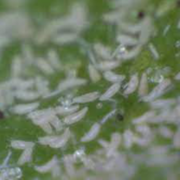
Tomato Russet mite
This minute mite forms huge colonies on the stems of tomato or aubergine plants, which show up as a ‘rust-coloured’ mass which spreads along the stem. Aculops lycopersici belongs to the family Eriophyidae, which are characteristically tiny and ‘worm-like’ in appearance. Other species in the same family cause russetting on apples and citrus fruits, and form galls on the leaves of plants. Until recently, there were no adequate biological controls for this pest. Trials had shown that Amblyseius cucumeris, Amblyseius californicus and Amblyseius montdorensis were able to feed on the mite, but they did not gave adequate control of the pest in glasshouse situations. The best results were obtained from the use of Amblyline CRS sachets (Amblyseius cucumeris), which slowed the spread of infestation on individual plants but did not stop it. Amblyseius andersoni, a predatory mite recently introduced into commercial production, has now changed that situation. This predator is available in our patented Anderline Gemini sachets, which release several hundred predators onto the crop over a period of several weeks. The Gemini sachets should be hung as high as possible on the plants, so that the predators are released in front of the advancing Rust Mite infestation. Trials in commercial tomato crops have shown that predators colonise the entire plant, and are able to prevent severe damage when used early enough.
-
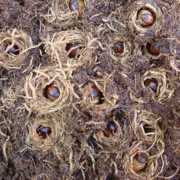
Vine Weevil
Commonly known as Vine Weevil or Black Vine Weevil. Adults of this beetle are about 1 cm long, and light grey-brown in colour with paler marks. They cause a characteristic notch in the leaves of ornamental plants when they feed. The beetles are nocturnal, and hide during the day, so that damage is often apparent even when no beetles can be found. All adult beetles are female and flightless: males are unknown. The principal damage is caused by the larvae, which feed on plant roots. Heavy infestations can severely damage the roots of fruit crops such as strawberry, ornamental plants such as Primula and hardy shrubs and trees such as Choysia and Taxus. Adults lay eggs close to the roots of plants, and the young larvae which hatch begin to feed underground. Light infestations are tolerated, but in heavy infestations enough of the root mass is consumed to reduce plant growth or result in death. Mature larvae are characteristically C-shaped, and are shining white with a distinct brown head. Movement is sluggish, but they will burrow back into the soil if disturbed. The majority of eggs are laid during August, and young larvae hatch and begin to feed during September. They become active again as soil temperatures rise in the spring, and complete their development and pupate during May and June. It is now known that many of the adults are long lived, they can survive winter conditions and begin to lay eggs during the spring. Thus larvae of various ages can coexist on plants. Control is normally achieved with entomopathogenic nematodes such as Steinernema carpocapsae and Heterorhabditis spp. These are capable of infecting and killing larvae at soil temperatures above 12-14° C. Larvae can become active and feed at lower temperatures, so in spring conditions where soil temperature does not rise above 14° C, larvae can continue to grow and cause plant damage. This limitation has been largely overcome with the introduction of the cold tolerant nematode Steinernema kraussei, which remains active at temperatures as low as 5° C. The larva of the Vine Weevil becomes darkened when infected with nematodes.
-
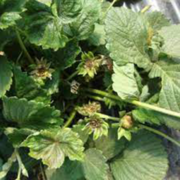
Broad Mite and Cyclamen Mite
These tiny mites can cause immense damage to plants, and yet are difficult to see, and often not present on the leaves that show the damage symptoms. This is because they occur in the very middle of the growing point of the plant, where new leaves are being formed but have not yet expanded. They feed on this delicate leaf tissue, and as the leaf expands it becomes distorted. Some types of plants show less distortion, but affected leaves often appear glossy and discoloured. Heavily infested plants can become severely distorted, and infestation can rapidly spread through a crop from an initial focus. The pest can be controlled biologically with high doses of Amblyline (Amblyseius cucumeris) or Anderline (Amblyseius andersoni) applied onto and around the foci of infestation. Lower rates must be applied around the area of visible damage, as the pest is almost certainly present in lower numbers, even when no damage is yet apparent. Californiline (Amblyseius californicus) has also been shown to offer control, but this is not available for use on outdoor crops in some countries.
-
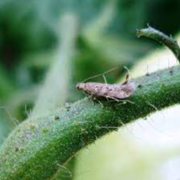
Tuta absoluta (Tomato Moth)
The South American Tomato Leaf Miner/Moth (Tuta absoluta) is the major pest of tomatoes in Brazil. It first appeared in the Mediterranean region in 2006. The spread of the pest has been exceptionally rapid, and it is now present throughout Europe, the Middle East and North Africa. The main method of dispersal is believed to be with harvested tomatoes, as the Tuta absoluta larvae emerge from the fruit post-harvest and pupate in the boxes used for shipment. First captures of moth infestations are often found in pheromone traps placed inside packing houses where imported fruit is being processed. It is a lepidopteran leaf miner that can have up to 12 generations in a year, with each female producing up to 250 eggs. The larvae are voracious feeders. They will burrow into leaves, creating characteristic galleries, as well as into stems and fruit. The damage can often cause complete crop loss. Tuta absoluta has a high reproductive potential. Larvae don’t enter diapause as long as food is available. The biological cycle is completed in 29–38 days depending on environmental conditions. Studies in Chile have shown that development takes 76.3 days at 14°C, 39.8 at 19.7 °C and 23.8 at 27.1 °C. Adults are nocturnal and usually hide during the day between leaves. Females lay eggs on aerial parts of their host plants. Four larval instars develop. Young larvae appear at the end of winter. Pupation may take place in the soil, on the leaf surface or within mines, depending on environmental conditions. When Tuta absoluta does not pupate in the soil, a cocoon is usually built. The pest may overwinter as eggs, pupae or adults. The pest will attack the tomato plant at any stage, even when the plant has only a few developed leaves. Tuta absoluta is a pest that is vulnerable to predators and parasites. Natural reductions in infestations can be as high as 75% from a combination of predation from predatory bugs and native parasites. There is growing evidence that naturally occurring parasites are adapting to T. absoluta in Spain, and reducing the levels of pest infestation in the local environment. The first line of defence against Tuta absoluta is correct use of pheromone traps inside and outside of the greenhouse. This can be followed by early introductions of predatory bugs such as Macroline (Macrolophus pygmaeus) or Nesiline (Nesidiocoris tenuis). The biopesticide Bacillus thuriengensis will also give a significant contribution to control. Parasites such as Trichogramma spp, will also give suppression of infestations. Hygiene is also very important. Thorough removal of crop waste at the end of the season will reduce the number of Tuta absoluta surviving to infest subsequent crops.
-
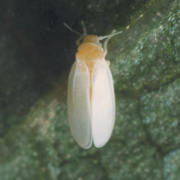
Bemisia Whitefly
The Tobacco or Silverleaf Whitefly is now the dominant whitefly pest in Mediterranean regions and appears to be spreading northwards. As with the Glasshouse whitefly, the larvae produce copious amounts of honeydew, but adults invading the crop also introduce virus diseases which can devastate the crop. Bemisia tabaci is recorded as the vector of 111 virus diseases of plants around the world. In tomatoes the principal virus is Tomato Yellow Leaf-Curl Virus (TYLCV), whilst in cucurbits there are several species with different symptoms, such as Cucumber Vein Yellowing Virus (CVYV) and Cucurbit Yellow Stunting Disorder Virus (CYSDV). The adult Tobacco Whitefly holds its wings alongside the body, revealing the yellow body colour and giving them an elliptical profile. This is in contrast to the Glasshouse Whitefly, which holds its wings in a tent-like fashion over the body, hiding the body and giving it a triangular outline. Adult Bemisia tabaci will settle and feed on much older leaves than Trialeurodes vaporariorum, so all stages can occur on any part of the plant. Larvae of Bemisia tabaci are generally smaller than those of Trialeurodes vaporariorum, slightly pointed towards the rear end, and remain flattened throughout their development. Trialeurodes vaporariorum larvae are smoothly elliptical, and during the later instars become distinctly thickened, with vertical sides.
-
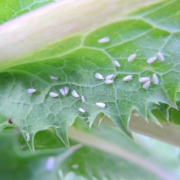
Glasshouse Whitefly
The adult Glasshouse Whitefly holds its wings in a tent-like fashion over the body, hiding the body and giving it a triangular outline. This is in contrast to Bemisia tabaci, adults of which hold the wings alongside the body, revealing the yellow body colour and giving them an elliptical profile. Adults of T. vaporariorum generally settle on young foliage close to the growing point of the plant, and lay eggs there. Eggs are creamy white in colour when first laid, but turn black within 24 hours. The larvae that hatch are initially mobile, and are known as ‘crawlers’. These soon settle, and the rest of the larval stages are immobile. In rapidly growing plants such as commercially grown tomatoes, this often leads to a stratification of whitefly ages on the plant, with adults and eggs at the top, young larvae a little lower, larger larvae towards the middle of the plant, and pupae towards the base. Feeding larvae draw sap from the plant, extract proteins and other nutrients, and excrete the surplus sugars, which are present in the sap as ‘honeydew’. At high populations, the copious honeydew produced leads to the leaves or fruit becoming sticky, and to the growth of sooty moulds which restrict photosynthesis, and are unsightly. Trialeurodes vaporariorum can also transmit some virus diseases to plants, but is less important in this respect than Bemisia tabaci. Development is temperature dependent, and may also vary with the crop and cultivar. Some example figures are shown below
-
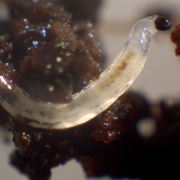
Sciarids/Fungus Gnats
Several species of Sciarid Fly can cause problems, but the most commonly encountered seems to be Bradysia paupera. The related Lycoriella spp are also known as pests in mushroom cultivation. Adults are commonly seen around potted plants in the home and in offices, where they are sometimes mistaken for midges. In nurseries they can be seen hovering in small clouds above prominent objects, especially where there are wet areas. They can occur in the same areas as Shore Flies (Scatella spp) which feed on algae, and Moth Flies (Psychodidae). It was thought that the flies were merely a nuisance and did not cause significant damage, arriving only when an existing fungal infection produced suitable food for the larvae. It has now been confirmed that the adult flies are responsible for the spread of some fungal diseases of plants. Eggs are laid into moist soil or organic debris. The larvae are translucent white with no legs and a distinct black head, and about 1 cm long when fully grown. They feed on fungi and decaying plant material, but will also feed on live plant roots, and can burrow into the stems of newly taken cuttings of plants such as Poinsettias.
-
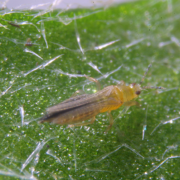
Thrips
Frankliniella occidentalis- known as Western Flower Thrips or Californian Thrips, is a small insect originating on the West Coast of North America, which spread through much of Europe in the 1980’s as a consequence of the international trade in plants. It is now established as a major pest in most parts of the world. Adult thrips have delicate, hair-fringed wings that allow them to move into and through crops. Western Flower Thrips adults are attracted by flower odours. Once in flowers, they feed on pollen and on developing petals, causing blemishes that reduce the value of cut flowers. Some flower varieties and colours are more prone to damage than others. Eggs are generally laid in leaf tissue or developing fruit, and can cause small, hard, ‘warts’. Feeding on developing fruit also causes damage, typically seen as a roughening and hardening of the surface. In sweet peppers this generally shows as a ‘corkiness’ of the surface, whilst in strawberries the affected areas fail to develop, and can appear golden: the fruit becomes distorted, and market value is reduced. Larvae are small, usually orange in colour, and have only two feeding stages before dropping to the ground. In the upper layers of the soil they form a non-feeding pre-pupa, then a pupa, and at this stage they are vulnerable to some soil dwelling predators. Some pupation can also occur amongst foliage. Frankliniella occidentalis is also responsible for transmission of numerous virus diseases to plants, the most important of which are protected crops are Tomato Spotted Wilt Virus (TSWV) and Impatiens Necrotic Spot Virus (INSV), both affecting peppers and a wide range of ornamental crops. Virus diseases are generally acquired by first instar larvae feeding on infected leaf tissue. These larvae are unable to transmit the virus until they become adults. Later larval stages and adults are unable to acquire the virus, but infected adults can transmit virus to fresh, uninfected plants, thus spreading the disease from plant to plant within the crop, and into new crops. Other species of thrip are also major crops pests, including Onion thrips (Thrips tabaci).
